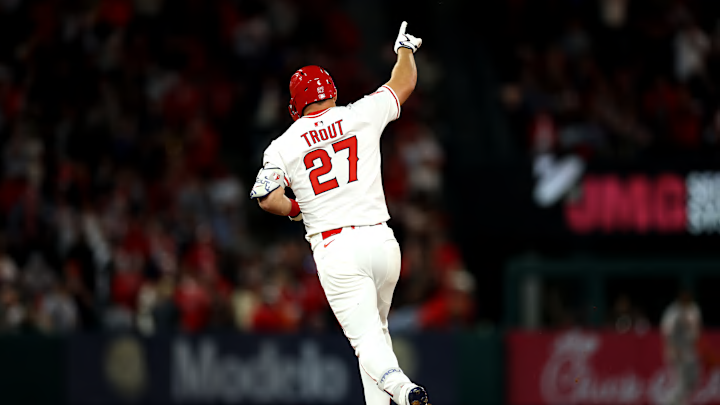The Angels entered the season with a clear goal in mind: to play competitive baseball and get some answers about their young core and some other foundational pieces as they move forward along the contention timeline.
With an easy schedule to start the season, the Angels started off hot, and it looked as if the puzzle pieces were about to fall into place. However, as the opponents got tougher, the Angels hit a skid and have been hovering around .500 over the last several games.
The team is still without clear answers on some of the biggest questions they faced heading into the season, and they will need to figure out the answers sooner rather than later in order to navigate the road ahead.
Can Mike Trout stay healthy and productive in the middle of the Angels' lineup?
From 2021 to 2024, Mike Trout averaged just 66.5 games played per season, and the Angels unsurprisingly floundered as a result. For the Angels to get where they want to go, the future Hall of Famer will need to prove that he can both stay healthy and return to his form as one of the very best players in all of baseball.
Only time can answer the health question for Trout, though he's rapidly closing in on his games played total from last season, 29, and adapting well to the move from center to right field that is designed to help preserve his body.
The question of performance, however, is much more complex. Trout worked over the offseason to try to rediscover his old form, adjusting the positioning of his hands in his setup with the goal of producing both power and contact, as he was renowned for earlier in his career.
So far, the results have been a mixed bag. Trout's eight homers through 22 games are just one off the major league lead, however, he's hitting just .177 with a .128 BABIP that ranks 171st out of 172 qualified hitters.
The underlying data paints an interesting picture. Trout's average exit velocity of 92.0 miles per hour is elite, and slightly above his career average of 91.3 miles per hour. His barrel rate, 20%, would be a career-high if he can keep it up for the whole season. That lines up with his fantastic hard hit percentage of 52.7%, well above his career mark of an already stellar 46.1%.
All of that points to a performance that should be much better than what it is. Trout's expected batting average is .277, a full 100 points better than the .177 mark he's posted.
With that said, there are also some concerning issues. First, Trout's line drive rate has plummeted. For his career, he owns a line drive rate of 22.1%; however, so far this season, he's seen that number nosedive nearly 10 points down to 12.7%.
At the same time, Trout's fly ball rate has soared. On the season, he's up to 54.5% fly balls versus a healthier 42.8% for his career. An increase in flyball rate isn't necessarily a bad thing. Fly balls have the best shot of leaving the yard and doing maximum damage, especially if hit hard like Trout has done so far this season.
However, when they aren't flying over the fence, they rarely produce hits, while line drives are by far the biggest hit-producing type of contact. This trend is somewhat of a continuation of last season, when Trout also saw his fly ball rate rise up to the 56.1% mark while hitting just .220.
A few other areas of possible concern exist as well. Trout's strikeout rate is rising. For his career, his 22.4% K-rate is about league average, however, this season he's sitting at 27.7%, continuing a trend of elevated strikeouts that began with a 28.1% K-rate back in 2021.
After so many injuries and now at 33 years old, it would be unreasonable to expect Trout to return to the rarified air of his absolute peak. With that said, the Angels are going to need to see that he can produce in line with what the expected stats say, rather than operate as a three-true-outcomes type hitter, as his results indicate thus far.
The season is still young, but the Halos will need Trout to return to form to be their offensive engine if they hope to truly play competitive baseball this year.
